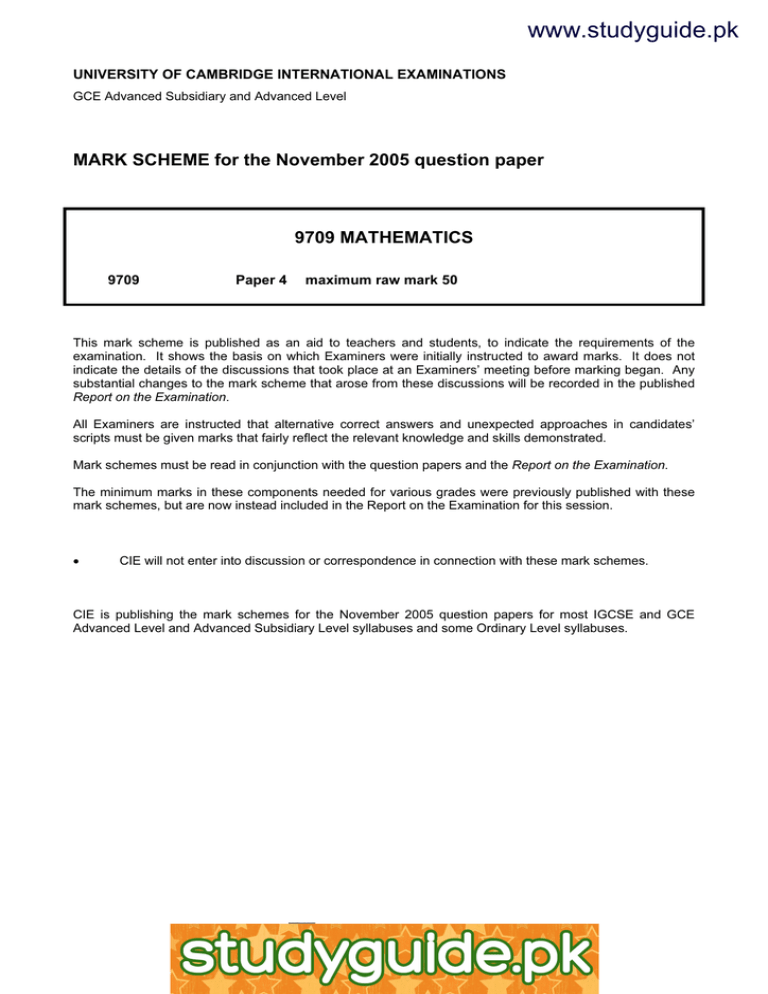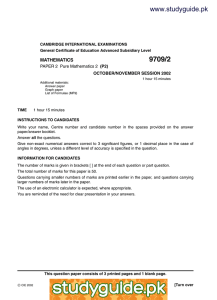www.studyguide.pk MARK SCHEME for the November 2005 question paper 9709 MATHEMATICS
advertisement

www.studyguide.pk UNIVERSITY OF CAMBRIDGE INTERNATIONAL EXAMINATIONS GCE Advanced Subsidiary and Advanced Level MARK SCHEME for the November 2005 question paper 9709 MATHEMATICS 9709 Paper 4 maximum raw mark 50 This mark scheme is published as an aid to teachers and students, to indicate the requirements of the examination. It shows the basis on which Examiners were initially instructed to award marks. It does not indicate the details of the discussions that took place at an Examiners’ meeting before marking began. Any substantial changes to the mark scheme that arose from these discussions will be recorded in the published Report on the Examination. All Examiners are instructed that alternative correct answers and unexpected approaches in candidates’ scripts must be given marks that fairly reflect the relevant knowledge and skills demonstrated. Mark schemes must be read in conjunction with the question papers and the Report on the Examination. The minimum marks in these components needed for various grades were previously published with these mark schemes, but are now instead included in the Report on the Examination for this session. • CIE will not enter into discussion or correspondence in connection with these mark schemes. CIE is publishing the mark schemes for the November 2005 question papers for most IGCSE and GCE Advanced Level and Advanced Subsidiary Level syllabuses and some Ordinary Level syllabuses. www.xtremepapers.net www.studyguide.pk Mark Scheme Notes Marks are of the following three types: M Method mark, awarded for a valid method applied to the problem. Method marks are not lost for numerical errors, algebraic slips or errors in units. However, it is not usually sufficient for a candidate just to indicate an intention of using some method or just to quote a formula; the formula or idea must be applied to the specific problem in hand, e.g. by substituting the relevant quantities into the formula. Correct application of a formula without the formula being quoted obviously earns the M mark and in some cases an M mark can be implied from a correct answer. A Accuracy mark, awarded for a correct answer or intermediate step correctly obtained. Accuracy marks cannot be given unless the associated method mark is earned (or implied). B Mark for a correct result or statement independent of method marks. • When a part of a question has two or more "method" steps, the M marks are generally independent unless the scheme specifically says otherwise; and similarly when there are several B marks allocated. The notation DM or DB (or dep*) is used to indicate that a particular M or B mark is dependent on an earlier M or B (asterisked) mark in the scheme. When two or more steps are run together by the candidate, the earlier marks are implied and full credit is given. • The symbol √ implies that the A or B mark indicated is allowed for work correctly following on from previously incorrect results. Otherwise, A or B marks are given for correct work only. A and B marks are not given for fortuitously "correct" answers or results obtained from incorrect working. • Note: B2 or A2 means that the candidate can earn 2 or 0. B2/1/0 means that the candidate can earn anything from 0 to 2. The marks indicated in the scheme may not be subdivided. If there is genuine doubt whether a candidate has earned a mark, allow the candidate the benefit of the doubt. Unless otherwise indicated, marks once gained cannot subsequently be lost, e.g. wrong working following a correct form of answer is ignored. • Wrong or missing units in an answer should not lead to the loss of a mark unless the scheme specifically indicates otherwise. • For a numerical answer, allow the A or B mark if a value is obtained which is correct to 3 s.f., or which would be correct to 3 s.f. if rounded (1 d.p. in the case of an angle). As stated above, an A or B mark is not given if a correct numerical answer arises fortuitously from incorrect working. For Mechanics questions, allow A or B marks for correct answers which arise from taking g equal to 9.8 or 9.81 instead of 10. www.xtremepapers.net www.studyguide.pk The following abbreviations may be used in a mark scheme or used on the scripts: AEF Any Equivalent Form (of answer is equally acceptable) AG Answer Given on the question paper (so extra checking is needed to ensure that the detailed working leading to the result is valid) BOD Benefit of Doubt (allowed when the validity of a solution may not be absolutely clear) CAO Correct Answer Only (emphasising that no "follow through" from a previous error is allowed) CWO Correct Working Only – often written by a ‘fortuitous' answer ISW Ignore Subsequent Working MR Misread PA Premature Approximation (resulting in basically correct work that is insufficiently accurate) SOS See Other Solution (the candidate makes a better attempt at the same question) SR Special Ruling (detailing the mark to be given for a specific wrong solution, or a case where some standard marking practice is to be varied in the light of a particular circumstance) Penalties MR -1 A penalty of MR -1 is deducted from A or B marks when the data of a question or part question are genuinely misread and the object and difficulty of the question remain unaltered. In this case all A and B marks then become "follow through √" marks. MR is not applied when the candidate misreads his own figures – this is regarded as an error in accuracy. An MR-2 penalty may be applied in particular cases if agreed at the coordination meeting. PA -1 This is deducted from A or B marks in the case of premature approximation. The PA -1 penalty is usually discussed at the meeting. www.xtremepapers.net www.studyguide.pk Page 1 1 (i) (ii) 2 3 Mark Scheme GCE A/AS LEVEL – November 2005 (i) (ii) (iii) 2 M1 A1 2 (a) 7 – 5 = 2ad1, (b) 82 – 72 = 2ad2 d 24 = 1 15 d2 d1 = 1.6d2 2 For eliminating a M1 2 ½ 50 × 22 = 100 J 250 × 20 = 5000 J WD by the force = 5100 J or a = 1/10 5100 = 400 × 20cos α or 400 cos α – 250 = 50 × 1/10 B1 B1 B1 1 1 α = 50.4 A1 W W1N 1N 5N 80 60 WW2N 2N W1 5 = o sin 60 sin80o W1 = 4.40 W2 sin 40o For using WD by the force = or for using Fd cos α Newton’s second law (3 terms required) M1 3 M1 For correct triangle of forces or for resolving forces at the knot either horizontally or vertically A1 For correct angles and sides marked on the triangle of forces (or later correctly used) or for two correct equations in W1 and W2 M1 For using the sine rule in the triangle of forces to obtain an equation in W1 or W2 only, or for eliminating W2 (or W1) from simultaneous equations Or 40 = W2 = 3.26 W1sin40o = W2sin60o W1cos40o + W2cos60o = 5 W1cos40o + o W1 sin 40 cos60o =5 sin 60 o W1 = 4.40 o 5 W2 = 4.40 sin 40 o sin 60 sin 80o W2 = 3.26 Paper 04 For using v2 = u2 + 2as A1 Either Syllabus 9709 A1 For using the sine rule in the triangle of forces again to obtain an equation in W2 or W1 only, or for back substitution to obtain an equation in W2 (or W1) only M1 A1 6 © University of Cambridge International Examinations 2005 www.xtremepapers.net www.studyguide.pk Page 2 4 (i) (ii) Mark Scheme GCE A/AS LEVEL – November 2005 N + Xcos θ = mg N + X(24/25) = 320 × 10 N = 3200 – (24/25)X F = Xsin θ M1 A1 A1 M1 X = 1875 M1 A1 7 3 24 X = ( 3200 − X ) 25 8 25 5 (i) 560 600 t 3 For resolving forces horizontally For using F = µ N to obtain an equation in X only 3 M1 For 3 straight line segments; v(t) positive for 0 < t < 600, continuous and single valued. A1 End points (t = 0, t = 600) on t axis A1 3 +ve, zero and –ve gradients in order (ii) For using the idea that the area of the triangle represents distance, or for using [(0) + v] ÷ 2 = s ÷ t ½ 80v = 400 Velocity is 10 ms-1 M1 A1 D = ½ (600 + 480)10 Total distance is 5400 m M1 A1ft 2 (iii) For using the idea that the area of the trapezium represents total distance 2 (iv) Acceleration is 0.125 ms-2 for 0 < t < 80 6 (i) (ii) (iii) For using the idea that gradient represents acceleration, or for using v = (0) + at M1 A1ft 2 M1 2 3 Paper 04 For resolving forces vertically (3 terms needed) v 80 Syllabus 9709 s = 4t – 2t /3 (+C) s = 4 × 9 – (2/3)27 A1 M1 Distance is 18 m s = -54/t (+C) 18 = -54/3 + C Displacement is 36 – 54/t 36 – 54/t = 27 t = 6 A1 B1 M1 A1 M1* v = 54/36 M1*dep v = 1.5 A1 For using s = ∫ vdt in (i) or (ii) For using limits 0, 3 or equivalent (may be implied by absence of C and substituting t = 3) 4 For using s(3) = ans(i) 3 For solving s(t) = 27 and For substituting value of t found into v(t) 3 © University of Cambridge International Examinations 2005 www.xtremepapers.net www.studyguide.pk Page 3 7 Mark Scheme GCE A/AS LEVEL – November 2005 (i) M1 0.3g – T = 0.3a, T – 0.2g = 0.2a 0.3g – 0.2g = 0.3a + 0.2a a=2 A1 M1 A1 Syllabus 9709 Paper 04 For applying Newton’s second law to either particle For eliminating T 4 Alternatively: For using a = (ii) (iii) a=2 v = 2 × 1.2; Speed is 2.4 ms-1 s1 = ½ (0 + 2.4)1.2 2.42 = 2gs2 or PE gain while string is slack = ½ 0.2 × 2.42 (s1 + s2) = 1.728 or PE gain while string is slack =0.576J Total PE gain = 0.2g × 1.728 (or PE gain while string is taut = 0.2g × 1.44) B1 B1 M1 Total PE gain = 3.456 J A1 m1 − m2 g m1 + m2 M2 A2 1 For using u2 = 2gs or for using ‘gain in PE = loss in KE’ A1 M1 May be implied by final answer. For using PE gain = mg(s1 + s2) (or PE gain while string is taut = mgs1 , in the case where PE gain while string is slack is calculated separately) 5 © University of Cambridge International Examinations 2005 www.xtremepapers.net






